Yvette Stanton of Vetty Creations has done it again!
If you love whitework embroidery, you’ve probably heard of Yvette – and if you haven’t heard of her, you need to!
Yvette writes instructional and project books, mostly for specific whitework techniques. She’s published an impressive library of eight books so far, six of which are devoted to whitework. All of Yvette’s books are beautifully written and photographed and packed full of clear, accessible instructions that are suitable for beginners and beyond.
This eighth book – Early-Style Hardanger – does not disappoint. It is High Quality Yvette, all over the place. If you know her books, you’ll recognize her style, her attention to detail, her thorough instructions and her exquisite projects.
Let’s look at the book close up, shall we?
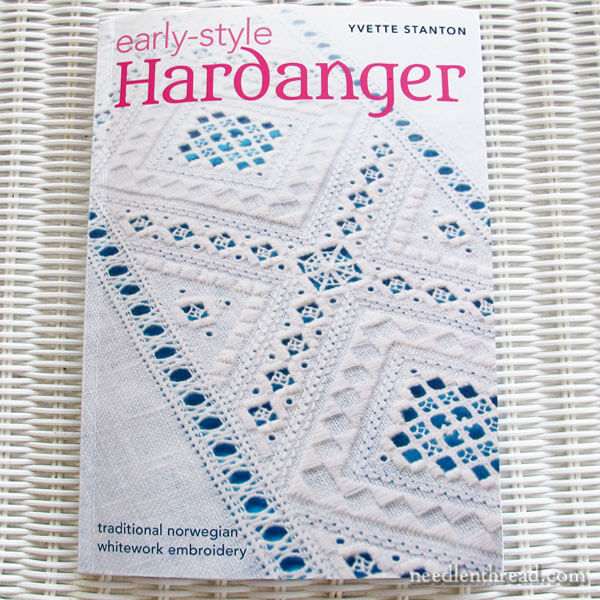
Early-Style Hardanger explores the counted whitework techniques of Hardanger embroidery as they originated from the Hardangerfjord region of western Norway.
For those who are familiar with Hardanger embroidery, Yvette’s introduction sets the stage for this book:
Forget everything you know or think you know about Hardanger embroidery. Early-style Hardanger embroidery is very different to what most of us recognise as Hardanger today…
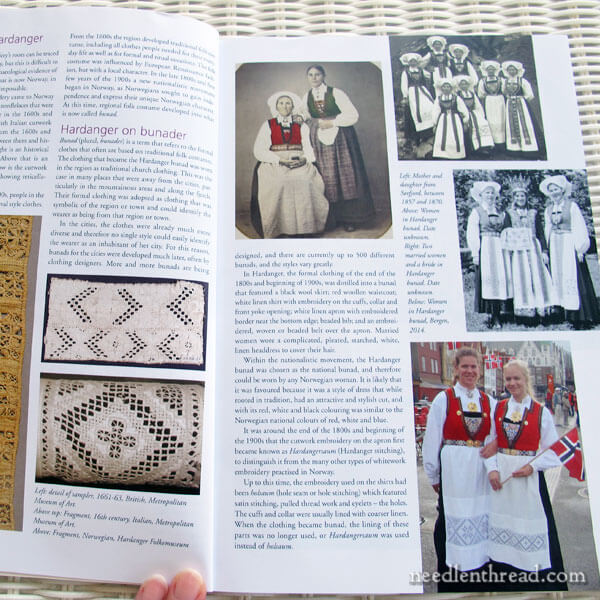
The book begins with a very readable introduction that delves into the history of Hardanger embroidery and explores it in its social context in Norway.
There are plenty of photos to enchant and delight!
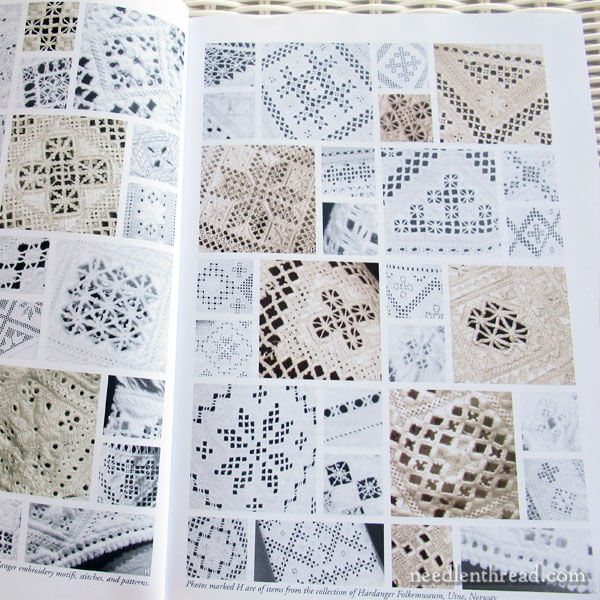
In fact, there are heaps of photos! I especially love the close-up pictures of examples of early-style Hardanger.
It’s amazing to think that, during a time when lighting wasn’t as convenient and ready as it is today, when magnification wasn’t really an option, ladies faithfully plied their needles, working over their precious linen to create a much finer, more intricate style of Hardanger than we see today.
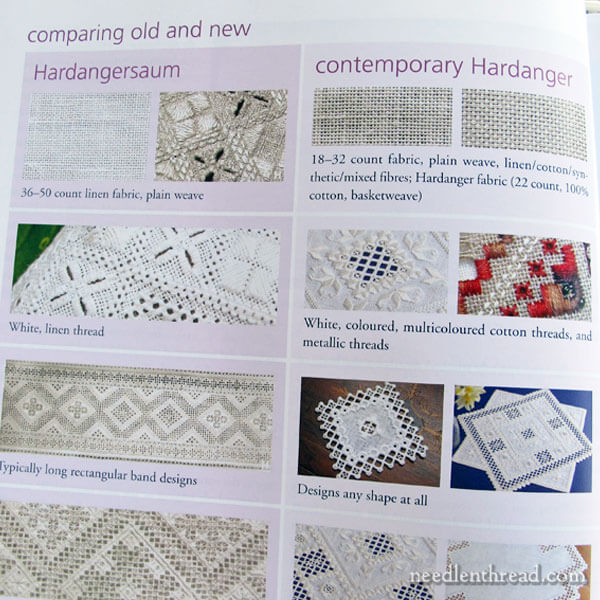
One of my favorite parts of the introduction is this comparison between old and new. Yvette lines up examples of early-style Hardanger with examples of contemporary Hardanger, so that we can easily see differences and recognize advantages in both styles.
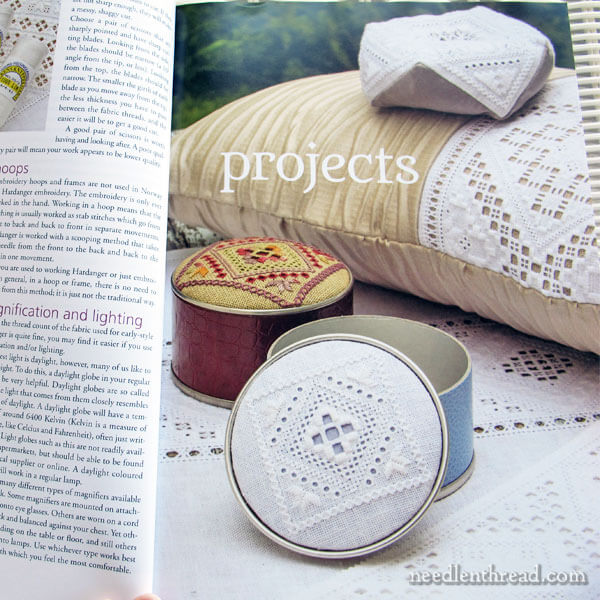
After the introduction, we jump straight into the Projects section of the book.
Wow!! If you want projects, you’ve got ’em! There are ten projects in the book, with detailed instructions on how to create them.
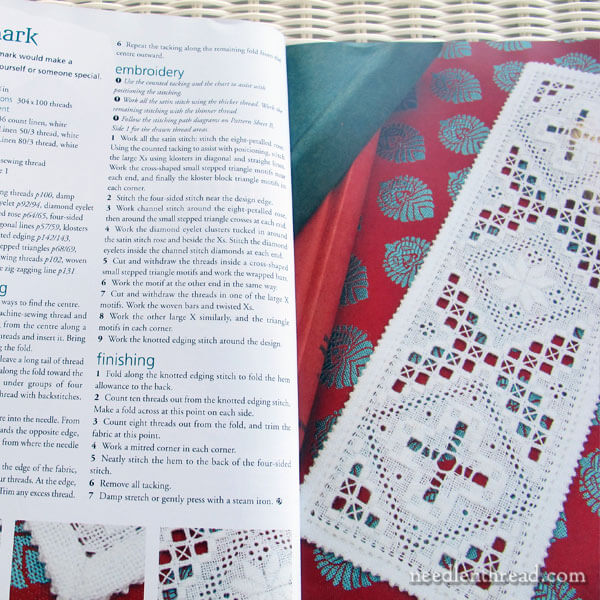
The projects range from small – like the bookmark above…
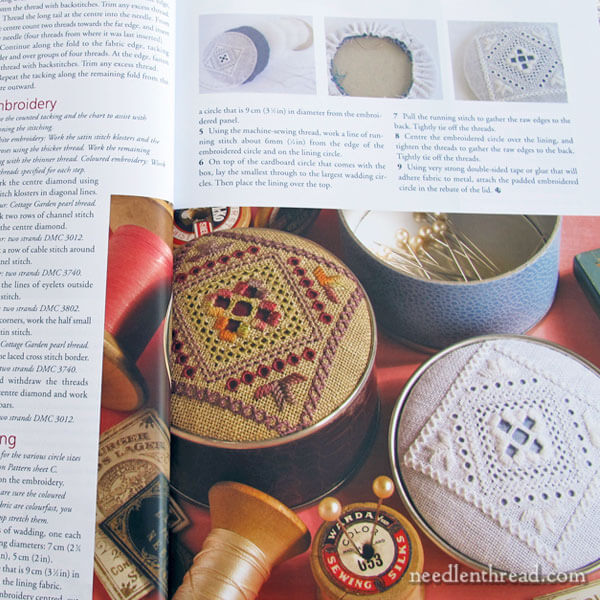
…or these pin tins…
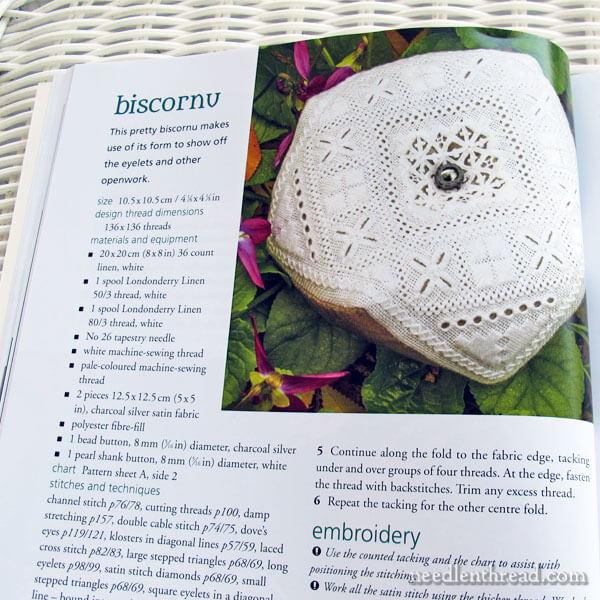
…or a lovely biscornu, perfect for a pin cushion…
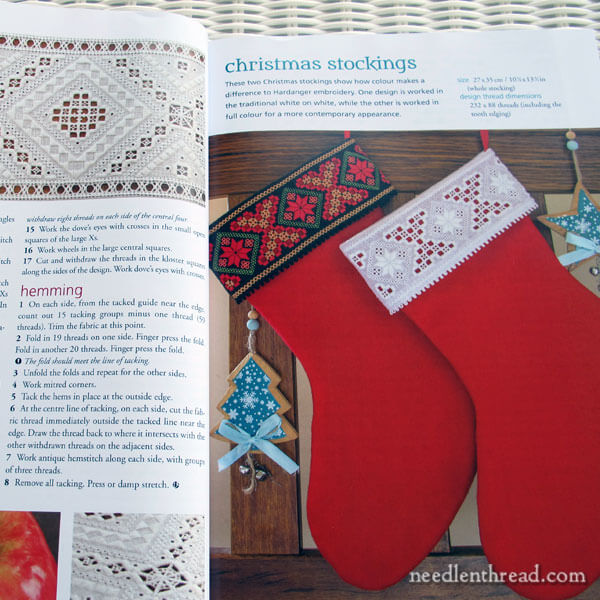
…or these adorable Christmas stockings…
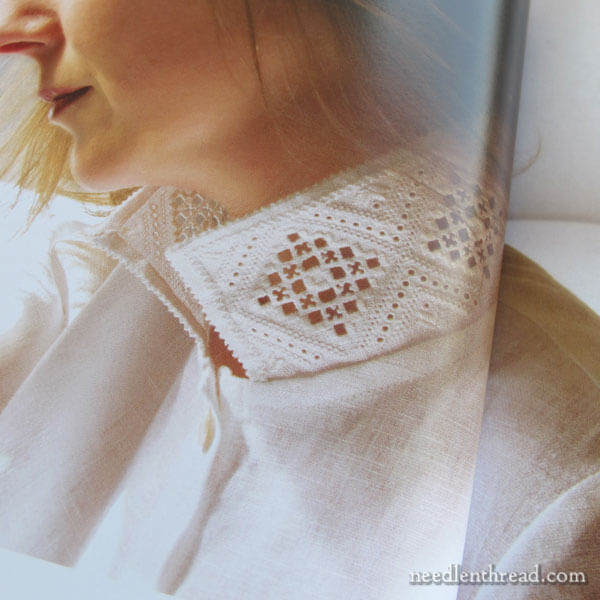
…to larger undertakings – like this oh-so-elegant linen blouse with a Hardanger collar…
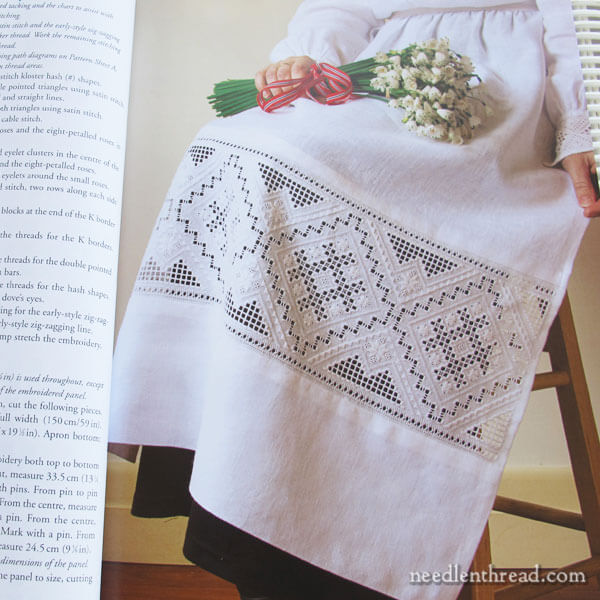
…or (my absolute favorite!) this glorious, crisp white apron, which I could never bring myself to wear in a kitchen. Or at least, not in my kitchen. It’s gorgeous!
My mind always boggles at the projects Yvette accomplishes for her books.
Think about it: it was just two years ago that Yvette’s last book, Sardinian Knotted Embroidery, was published. Two years later, here’s another book full of finished projects. Imagine the hours of stitching, the hours of finishing, the photographing, the editing of said photos, the writing of the book, the creation of all the instructional diagrams and patterns, the editing of the book (she self-publishes her books), and everything else… the stitching time, the computer time, the research time!
Not to mention the Mom time, the Wife time, the Teaching time, the Business time.
I’m telling you: my mind boggles!
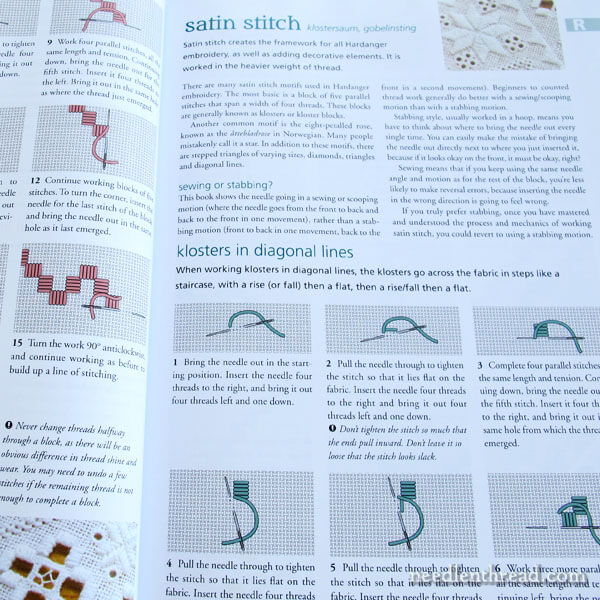
Ahem. Back on track.
Following the Projects section is the Very Thorough instructional section. Here’s where you’ll find all the how-to’s for all the different techniques featured in early-style Hardanger.
The instructions are written for both right and left handed stitchers, and are labeled appropriately.
All the stitching instructions are delivered via clear, step-by-step diagrams.
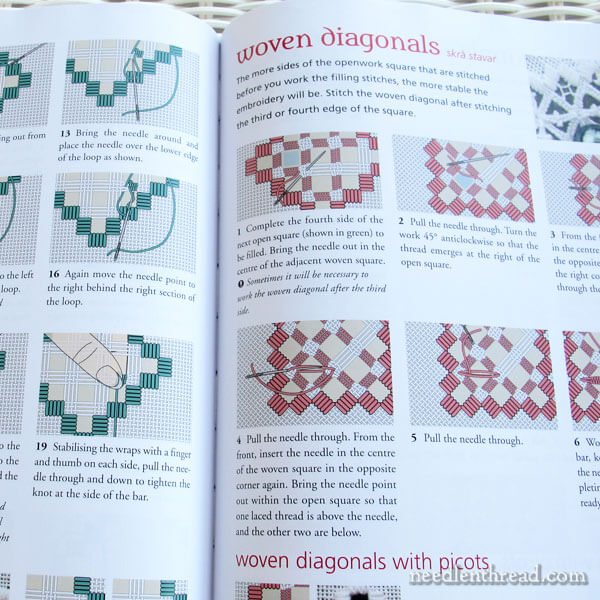
And there are lots of them! The bulk of the book, in fact, is the instructional content on stitching techniques, but keep in mind that they include diagrams for both righties and lefties.
Throughout the instructional content, you’ll also find little insets that troubleshoot common areas of difficulty for these techniques. I always find inset tips and troubleshooting to be very helpful.
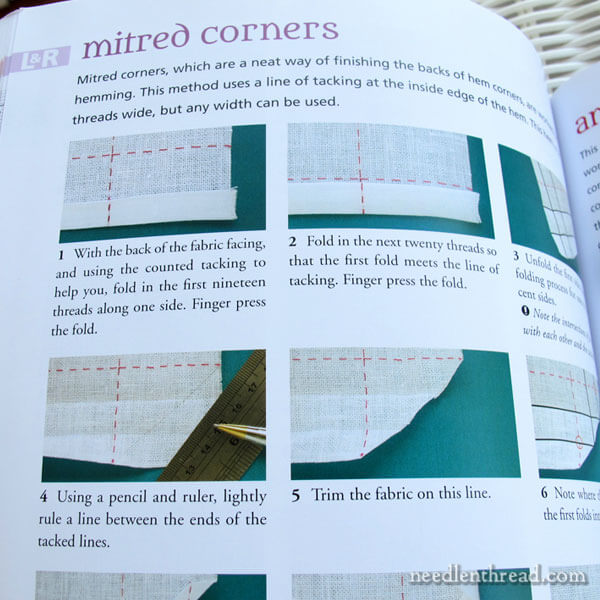
At the end of the stitching instructions, you’ll also find finishing instructions for things like mitering corners, damp stretching and blocking work, and so forth, to ensure that your embroidery looks as perfect as possible when you’re making it up into things.
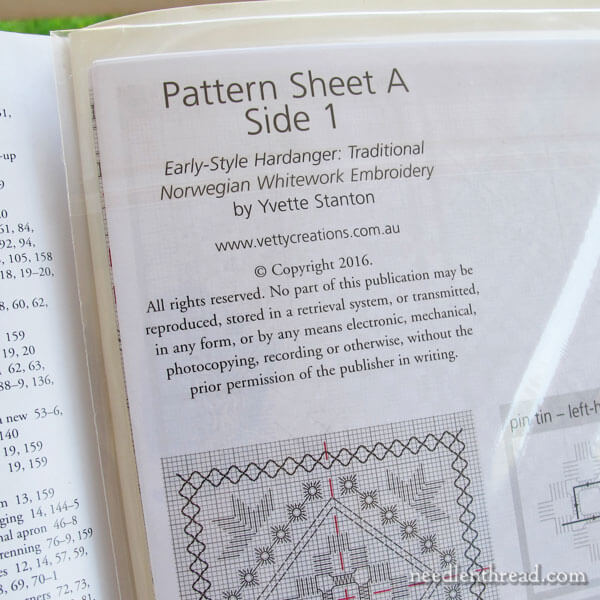
And finally, tucked in the back of the book is a pull-out pattern page.
In a Nutshell
If you love whitework, if you love counted whitework techniques, if you love Hardanger, if you love regional styles of embroidery, if you love linen, if you just love good instructional books – you’ll love this book! And you’ll want it in your needlework library!
Where to Find It
You can find Early-Style Hardanger directly through Vetty Creations out of Australia.
If you’re in the US, Early-style Hardanger is also available through Nordic Needle, which is a local needlework shop in Fargo, ND, with an excellent online shop for those of us who don’t have local shops nearby.
Another online shop that carries Early-Style Hardanger is Stitching Shop in Denver, Colorado.
If you have a local shop nearby, ask for Yvette’s books. If they don’t have them, they may be able to order them.
In the US, you can find Early Style Hardanger here through Amazon.
Online, world-wide, you can find Early-Style Hardanger through the following book affiliate: Book Depository out of the UK, with free shipping.







What count is the old style Hardanger done on? I would love the book, but my eyes are not what they used to be…
Based on the “comparing old and new” photo above, the “old” is shown at 36-50 count. (The new is shown as 18-32 count.)
HTH,
LisaAlissa
According to one of the pages shown above, the old style is done on 36-50 count while the new is on 18-32. Perhaps a good magnifier light would help.
It’s a great book, I’m very pleased with it. I also think the apron is my favourite project, Mary. (At least to admire, I can’t quite see myself making and wearing it). I’m currently working the bookmark project and that is taking me a good while, even on 36 count fabric, it isn’t something I can do much of at once, and only in a good light and with my strong spectacles. But the instructions are very, very clear, so it’s only the English summer, limited stitching time, and my powers of concentration that are slowing me down.
Wow – what a book! Thanks very much Mary.
How timely for me!!! I have just ordered 2 books on Hardanger from Nordic Needle! Gosh, I would love this one, but am afraid the price is going to keep me from it for awhile. I did some Hardanger in the past and would like to re-acquaint myself with it. Unfortunately I can not find my books since the move! Boo hoo… they must be here, they MUST be here…
Thanks Mary, this will go on my “wish list”.
What a fantastic book! Thank you for the detailed review.
My grandmother was from Norway. I’ve done a few small hardanger pieces on 32 count linen, and I’d like to try some of the patterns in the book. The Biscornu looks like a good project to try first.
One of my bucket-list places to visit is the Vesterheim Museum in Iowa. I read about it years ago in a stitching magazine, and the article had photos of the beautiful dresses and aprons with elaborate stitching.
Patti
Patti, It is a wonderful museum. If you can, you should go during the Nordicfest. Very fun. My husband and I took our motorcycle (stayed in Lanesboro as we decided too late to book a room in Decorah, but that really wasn’t that far, and Lanesboro is fun too). Had a blast that weekend, always wanted to go back, but you know how that goes. LOL.
Mary, I’ve been thinking about emailing you all week to find out if you were planning to review this very book! Thanks so much. I love Yvette’s books and have all but one of them. I adore whitework because of the light and shadow play on the threads. It is satisfying to embroider a project in the color of white and have it look like so much more than “just” white.
Regarding the pretty apron, just got a vintage copy of Egg Quilts by Eleanor Burns, and she relates a story of her grandmother. She wore a crisp white apron UNDER her colorful daily one, so if company showed up, she could whisk off the colorful, but mussed up one and look presentable.
It sounds silly, but I also found out that Burns and I are from the same area, and that is totally what my Nanny would have done.
This sounds a thoroughly sensible way of staying presentable – no looking for the “company” apron, having the good apron to hand, just quickly untying one (much faster than tying). But do many of us wear aprons these days?
You write the best book reviews, Mary! I have most of Yvette’s other books and this one is currently on its way to me from Nordic Needle (place the order a couple of days ago), so I LOVE the sneak peek via your review today. Thanks for all you do for all of us out here in needlework-land!
I truly love hardanger although I haven’t done much of it. Gratified to see the book is available through Nordic Needle. I have been very fortunate and blessed to live in the same town where Nordic Needle is based; the owners Ros and Sue are friends of mine as well. Great store! Thank you for your review of this very tempting book.
Another satisfied stitcher. I bought this book a few weeks ago and I am currently working on the cushion project. I’ve enjoyed working with the linen thread but watch out the four sided stitch. On some projects, it’s 3×3, not the usual 4×4. Oops…
I don’t own a lot of embroidery books but I have been very happy with this one.
Mary,
I read your review early Sunday morning, clicked on Yvette’s link and immediately purchased the book! The fact that I am not a competent embroiderer didn’t phase me at all!! But I love Hardanger …maybe I might perhaps be able to attempt her bookmark project….; my daughter lives in Bergen, Norway, and as a librarian in a previous life I am a sucker for beautiful books! Besides which it was a beautifully presented review. Thank you as always. Take care of yourself.
Mary,I am writing because some of your readers might have the same incorrect thought on wait list as I did.
After reading your review of Early Style Hardanger I ordered the book as a gift for my sister. I ordered from Nordic Needle. It had to be wait listed. I wrongly assumed wait listed meant a copy would be kept on the side for a few days when it arrived in stock. I was wrong. The email arrived in my box on Saturday. Their customer service is closed over the weekend, and on Monday morning I called the book was again sold out. Apparently wait list means go online and buy it quickly as the store does not wait for you to response to the email. After talking with customer service they will charge the book and send it to me when it arrives, again.
My best stitch is the one best suited to the task at hand. Hardanger is a fun technique because I like counting and love WOW aka White-On-White.
Your site continues to amaze me, Mary. Your followers are most generous, too.
Thank you.
I always wanted to learn Hardanger. The cutting of the threads is where I have trouble. Not that experience. this book looks like it could help me. I love the hardanger on the collar of a blouse.
Lee Ann Totzke
After borrowing this book from our Guild library, I now cannot wait to order it. I love counted work and now I understand how to master Hardanger. Thank you Yvette!
Where in South Africa can I buy your book?